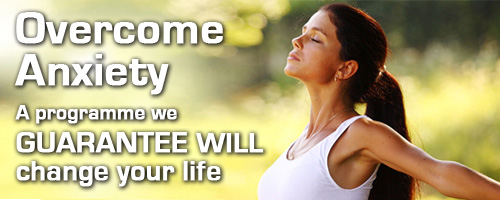 Dealing with anxiety
Dealing with anxiety
By Charlotte Fantelli
Dealing with anxiety can be very difficult. When tackling my own problems, I found that I had to learn to recognise how I was feeling and to manage my symptoms before they escalated too far.
I studied a few different techniques that encourage you to ‘rate your level of anxiety’. Once my level was rated, I could identify stress-reducing techniques suitable for that level of anxiety. This really helped me to identify my own stress levels and my needs at certain points. Over time I implemented this as part of my all-round anxiety management and it has been extremely effective.
The good thing about this model is its adaptability – you can work out which activities work for you at each stage and which don’t. I found that, in an effort to try and control my surroundings, I rationalised and over-analysed, which created much more stress for me. Although I like to be informed, I actually control anxiety much better with distraction – for example, if I am feeling anxious on a motorway, instead of thinking it through so much, I will listen to music and try to memorise the words, or write my next article in my head. Try out some of the strategies below and see what works for you.

Anxiety reducing strategies
Level 8 – Panic attack
Time to ride the storm.
-
Remember, panic attacks cannot do you physical harm.
-
Try and regulate your breathing and stay somewhere safe until it passes.
-
Positively affirm that you have ‘had a panic attack before’, or ‘This can not do me physical harm’, ‘I am not going mad, this is simply my bodies over active fight or flight response.’
Level 7 – Onset of panic attack
Stress-reducing activities should not be too difficult as at this level your ability to concentrate can be impaired, so try to distract yourself with very simple tasks.
-
Remind yourself of positive affirmations such as I have survived panic attacks before or I am a strong person, able to cope with these feelings.
-
Mental tasks such as counting things, thinking of as many girls’ names as you can, or recalling memorised information such as friends’ ages or makes of cars can distract without being too taxing.
-
Physical activities could include jumping on the spot or walking around the house. This will help use up the excess chemicals preparing you for ‘flight or fight’ mode.
Level 6 – High level anxiety
Your stress level is severe, you are probably contemplating what if? thoughts that are building your fear.
-
At this point you should focus on stopping the negative thought pattern and exercising your body and mind enough to reduce anxiety symptoms.
-
Mental tasks can include recalling educated affirmations such as My body is preparing to fight or flee, these symptoms are a physical response to danger, they are not a threat to me or I am not going mad, these symptoms will pass.
-
Try slightly less simple problems like counting backwards from 300 or recalling girls’ names/ makes of cars/ occupations for each letter of the alphabet starting at A.
-
Physical activities could include housework, vacuuming or washing windows – these are strenuous enough to fight physical chemical overload, and mentally stimulating enough toprovide distraction.
Level 5 – Moderate level anxiety
This is the time when fearful ‘dead end’ thoughts creep in; you feel afraid and need to rein in anxious feelings before they escalate.
-
Mental tasks that may help reduce this level of stress include easy to moderate puzzles such asword searches or arrow words. Jigsaw puzzles also give the brain enough activity and focus for this level of concentration ability.
-
Remind yourself that you have the ability to control your stress levels and that you can take control. Write down positive thoughts, for example: I have survived panic attacks before, they did not kill me, I did not go mad.
-
Physical activities might include some slightly more strenuous activity depending on your fitness levels. You may enjoy a workout DVD or doing 20 star jumps. Or follow David Morrell’s exercises on page 33 of issue 2 Uncovered magazine.
-
Breathing exercises can help, try:Breathing in fully, watching your tummy rise, filling your lungs while counting for four seconds, holding for four, then exhaling for four.
Level 4 – Low level anxiety
You feel distress, maybe that your anxiety is starting to build but you feel in control enough to proactively tackle it.
-
Practice rhythmic breathing as above (under level 5 anxiety): inhale for four, hold for four, out for four.
-
Mental tasks can be more demanding than at higher levels; you could read the article about anxiety, starting on p34 (Uncovered magazine issue 2), and educate yourself on your symptoms.
-
You could do a more taxing puzzle such as Sudoku or a crossword.
-
Physical tasks should include an aerobic exercise that will allow you to use up chemicals being produced by anxiety. Star jumps, running on the spot or step ups on your bottom stair, for example.
Level 3 – Discomfort
Momentary uneasiness or nervousness, if nipped in the bud, can be nothing more than discomfort. Taking control at this stage can be learned, and this is the stage to learn to recognise and act. Find activities that allow you to de-stress at this level, some suggestions include:
-
Mental tasks including writing an expression of how you are feeling, listening to music, reading a book.
-
Physical activities could include a good de-stressing kick-box, a run or Pilates: all good for managing stress.
Level 2 and below
Take time to recognise the things that make you feel relaxed. It is easy to remember the things that make you anxious, but it is harder to recall the things that make you anxiety-free. Make time for relaxation in your everyday life to keep levels of calm.
-
It is good to remind yourself of your achievements and gain knowledge about your fears while you are not under severe stress.
-
It is at this time that you can rationalise and digest logical information about subjects.
-
This is also a time to take stock and enjoy, knowing that you have been able to reduce your stress levels to a normal level and you will be able to this again.
Further help
For more information on anxiety please visit:
What Is Anxiety
Fight or Flight
Anxiety Symptoms
Anxiety Disorders
Coping with Anxiety
Generalised Anxiety Disorder
Panic Attacks
No More Panic
Anxiety Treatment
Anxiety Management
Managing Stress
Anxiety and Debt
Social Anxiety
Anxiety as a Result of Domestic Abuse
Work Related Stress
Anxiety and Substance Abuse






